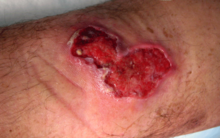Mycobacterium ulcerans
| Mycobacterium ulcerans | |
|---|---|

| |
| Scientific classification | |
| Domain: | Bacteria |
| Phylum: | Actinomycetota |
| Class: | Actinomycetia |
| Order: | Mycobacteriales |
| Family: | Mycobacteriaceae |
| Genus: | Mycobacterium |
| Species: | M. ulcerans
|
| Binomial name | |
| Mycobacterium ulcerans MacCallumet al.,1950
| |
Mycobacterium ulceransis a species of bacteria found in various aquatic environments. The bacteria can infect humans and some other animals, causing persistent open wounds calledBuruli ulcer.M. ulceransis closely related toMycobacterium marinum,from which it evolved around one million years ago, and more distantly to themycobacteriawhich causetuberculosisandleprosy.
Description
[edit]Mycobacterium ulceransarerod-shapedbacteria.[1]They appear purple ( "Gram positive") underGram stainand bright red ( "acid fast" ) underZiehl–Neelsen stain.[1]On laboratorymedia,M. ulceransgrow slowly, forming small transparentcoloniesafter four weeks.[1]As colonies age, they develop irregular outlines and a rough, yellow surface.[1]The bacteria was discovered by Australian scientistsJean Tolhurstand Glen Buckle in the late 1940s.
Taxonomy and evolution
[edit]Mycobacterium ulceransis a species ofmycobacteriawithin the phylumActinomycetota.Within the genusMycobacterium,M. ulceransis classified as both a "non-tuberculous mycobacterium" and a "slow-growing mycobacterium".[2]
| |||||||||||||||||||||||||||
| A cladogram showing the relationships among the mycobacteria that cause disease in humans.[3] |
M. ulceranslikely evolved from the closely related aquatic pathogenMycobacterium marinumaround one million years ago.[4]The two species are genetically very similar, and have identical16S ribosomal RNAgenes.[1]However relative toM. marinum,M. ulceranshas undergone substantialgenome reduction,shedding over a thousandkilobasesof genetic content including nearly 1300 genes (23% of the totalM. marinumgenes) and sustaining theinactivationof an additional 700 genes.[5]Some of these genes were inactivated by the proliferation of twomobile genetic elements,called "IS2404" (213 copies) and "IS2606" (91 copies), neither of which are present inM. marinum.[5]Additionally,M. ulceranshas acquired a 174 kilobaseplasmid,termed "pMUM001", which is involved in the production of the toxinmycolactone.[5]Other closely related mycobacteria produce mycolactone and infect various aquatic animals; these are sometimes described as distinct species (M. pseudoshottsii,M. liflandii,M. shinshuenseand sometimesM. marinum) and sometimes as different lineages ofM. ulcerans.Regardless, all mycolactone-producing mycobacteria share a common ancestor distinct from non-mycolactone-producingM. marinum.[6]
References
[edit]- ^abcdeMagee & Ward 2015,pp. 28–29.
- ^Bittner & Preheim 2016,pp. 5–6.
- ^Tortoli 2014,p. 739.
- ^Röltgen & Pluschke 2019,pp. 4–5.
- ^abcDemangel, Stinear & Cole 2009,pp. 52, 54.
- ^Vandelannoote et al. 2019,pp. 108–109.
Works cited
[edit]- Bittner MJ, Preheim LC (2016)."Other slow-growing nontuberculous mycobacteria".Microbiology Spectrum.4(6): TNM17–0012–2016.doi:10.1128/microbiolspec.TNMI7-0012-2016.PMID27837745.
- Demangel C, Stinear TP, Cole ST (2009)."Buruli ulcer: reductive evolution enhances pathogeneicity ofMycobacterium ulcerans".Nature Reviews Microbiology.7(1): 50–60.doi:10.1038/nrmicro2077.PMID19079352.
- Magee JG, Ward AC (September 2015). "Mycobacterium".In Whitman WB (ed.).Bergey's Manual of Systematics of Archaea and Bacteria.John Wiley & Sons, Bergey's Manual Trust. pp. 1–84.doi:10.1002/9781118960608.gbm00029.ISBN9781118960608.
- Röltgen K, Pluschke G (2019). "Buruli Ulcer: History and Disease Burden". In Röltgen K, Pluschke G (eds.).Buruli Ulcer: Mycobacterium Ulcerans Disease.Cham: Springer. pp. 1–41.doi:10.1007/978-3-030-11114-4_1.ISBN978-3-030-11113-7.PMID32091710.S2CID156014199.
- Tortoli E (2014)."Microbiological features and clinical relevance of new species of the genusMycobacterium".Clinical Microbiology Reviews.27(4): 727–752.doi:10.1128/CMR.00035-14.PMC4187642.PMID25278573.
- Vandelannoote K, Eddyani M, Buultjens A, Stinear TP (2019). "Population Genomics and Molecular Epidemiology ofMycobacterium ulcerans".In Röltgen K, Pluschke G (eds.).Buruli Ulcer: Mycobacterium Ulcerans Disease.Cham: Springer. pp. 107–115.doi:10.1007/978-3-030-11114-4_6.ISBN978-3-030-11113-7.PMID32091703.S2CID155720780.
- Willis, Rupert Allan (1967). "Jean Christa Tolhurst. 19 December 1911—20 November 1966".The Journal of Pathology and Bacteriology.94(2): 493–495.doi:10.1002/path.1700940240.ISSN0368-3494.
External links
[edit]- "Mycobacterium ulcerans".NCBI Taxonomy Browser.1809.
